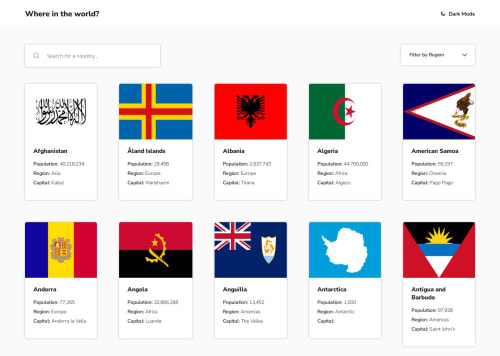React REST Countries API

Solution retrospective
I'm most proud of how well the country search works but I would definitely use a different API as this one gave me a lot of trouble displaying the data correctly
What challenges did you encounter, and how did you overcome them?As I wrote above, I had a problem with properly displaying data from the API and with hosting the entire website because I was using React Router. Eventually, I managed to find an article that explained to me that you need to use other commands than usual in the console to publish a page on GitHub
Please log in to post a comment
Log in with GitHubCommunity feedback
- @TedJenkler
Hi @Kamelek1337,
Nice project! Here are a few suggestions for improvement:
Mobile-First Approach: Your site currently isn’t responsive. To make your site easily responsive, consider using a mobile-first approach. Think of your site as a tower: if you start by building a solid foundation (mobile design), it will be easier to expand and adapt for larger screens. If you start with the top (desktop design), you’ll need more CSS to fix issues on mobile devices.
Mobile is the most important device nowadays, so ensuring it looks great on phones first is crucial. Use media queries to adjust the design for larger screens after establishing a solid mobile base.
Translate Border Names: To improve user experience, consider translating border abbreviations (like FRA) to their full names (e.g., France). This will make your content more accessible and understandable for all users.
Hope this was helpful
Best, Teodor
Marked as helpful
Join our Discord community
Join thousands of Frontend Mentor community members taking the challenges, sharing resources, helping each other, and chatting about all things front-end!
Join our Discord